We certainly started with a Bang! The deadline for our Laser reports was yesterday (Tuesday 24th Oct) at 4 pm. To achieve this date, we all seemed to have to work silly hours at the end. Working long hours all weekend wasn’t enough, and I started at 4.15am on Monday before lectures. Continuing again in the evening, following our lectures until 11pm. I had set my alarm for 5am on Tuesday but got up earlier and started again at 3.45am. I picked Mohammad up earlier at 7am so he could help me sort out my references and submit the reports. I say 7am, but he didn’t wake up until 7.04 when I texted him to see if he was awake. He had worked until 3am. We were all wiped out for our Matlab lectures on Tuesday, as GC Ren didn’t finish his off until 4am. He said that his submitted report contained 9000 words and that his thesis for his previous MSc only contained 8000. Mohamad had done 8900 and I had about 9050. Although mine had the most words, it also has the most waffle and bullshit so I expect the worst marks. I don’t care if I manage 50% to pass.
Although it’s been long and hard, we have learnt so much in such a short space of time. We used an ultrafast laser to machine our snake paths. Ultrafast has a wavelength of femto seconds (10 -15s or a millionth of a billionth of a second). Below is a micrograph of the corner of the silicon sample where we machined our snakes.
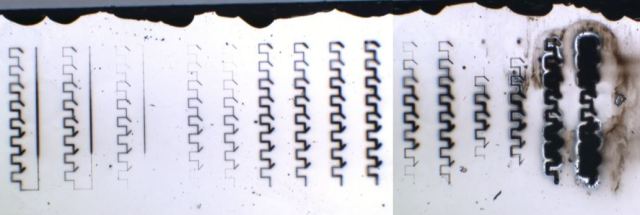
We started on around 32% power with our first cut, bottom right where it blasted the hell out of the silicon. We reduced the power with 2 attenuators progressively towards the left. Stepping over before each cut. The 3rd to last cut was our best but we did two more with increased mode power in case it was too feint to see well enough to measure the trench widths and depths. We started by measuring the track widths with a microscope and got what seemed like a consistent set of results. To get a better result we took 3 track widths for each leg of the snake and averaged them.
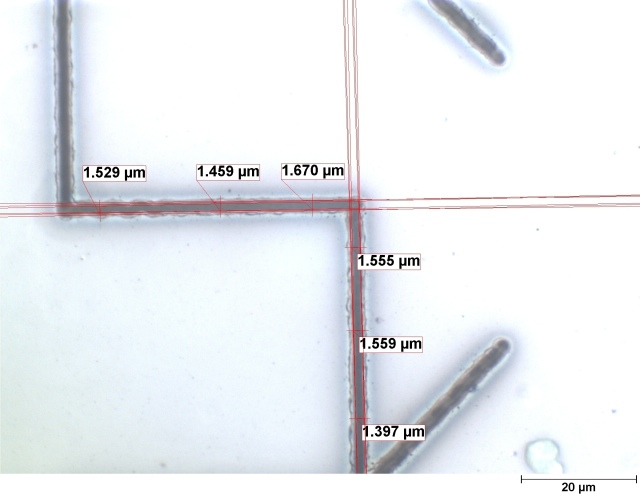
When we measured again using the interferometer microscope to find the depths we discovered that you should use an interferometer every time. You can place the cursor in an appropriate position on the sample and see cross sections of the sample surface. As the track width reading were much wider using the interferometer, we had to repeat our results again as they are obviously more accurate. We think that the dark lines that we measured on the microscope must be the shadowed part of the illumination which is part way down the sloping trench.
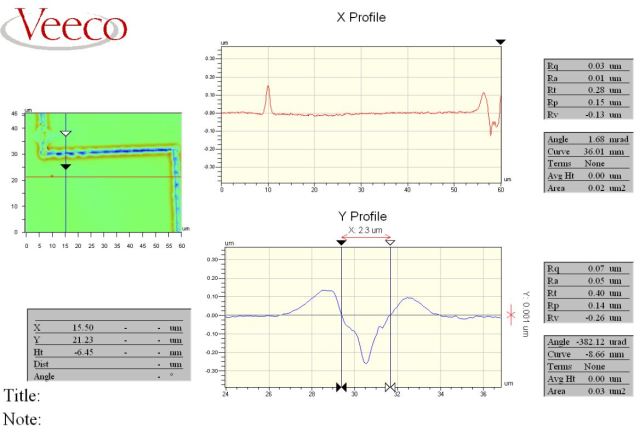
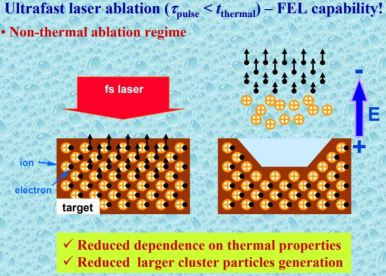 An ultrafast laser is so fast it doesn’t really have time to melt the target. It works by concentrated hi-power photons knocking valence electrons out of the target solid structure lattice. As these valance electrons are forming the covalent bonds within the crystal lattice, when they are removed these atoms become vaporised changing from solid to gas. The vaporised ions and free electrons are ejected as plasma. When there is a great enough concentration of photons to knock out electrons, the free electrons knock out other electrons in the structure and cause an avalanche of ionisation. This is called the ablation threshold. Oh shit, I wish I had written this in my report!
An ultrafast laser is so fast it doesn’t really have time to melt the target. It works by concentrated hi-power photons knocking valence electrons out of the target solid structure lattice. As these valance electrons are forming the covalent bonds within the crystal lattice, when they are removed these atoms become vaporised changing from solid to gas. The vaporised ions and free electrons are ejected as plasma. When there is a great enough concentration of photons to knock out electrons, the free electrons knock out other electrons in the structure and cause an avalanche of ionisation. This is called the ablation threshold. Oh shit, I wish I had written this in my report!
It’s quite interesting to look at the profile of the trenches, with the build-up of material either side of the trenches. It reminds me a bit of a meteorite crater. The shape of the trench is completely different but the sides are similar. I guess that some the free electrons hit ions to reform a solid again locally before they have chance to get too far apart. The extreme slopes and sharp base of the laser trench is interesting as well. I guess that the middle is where the highest concentration of photons is and so ionises the most matter on average. I suppose if it wasn’t such a quick pulse or stayed in the same place for more pulses, it would drill a parallel walled hole through the target. It’s amazing how much more you learn when writing up reports than you do in the lecture or laboratory work. The lab work and lectures are enjoyable but also necessary so you have something to research about. You can’t do this sort of research without the facilities in the first place.
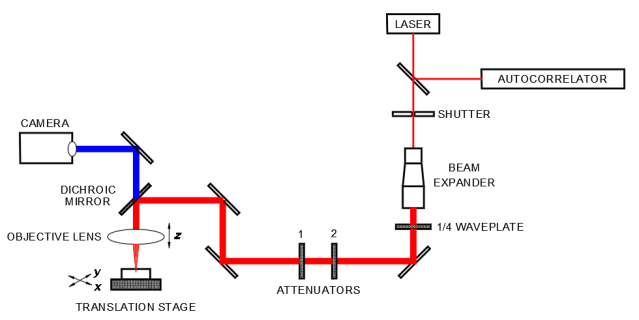
Back to work today for the first time since I started the course. Three new faces there, it doesn’t take long for changes to be made. My computer still doesn’t work and nobody has done a thing about it so not everything changes fast. It’s still nice to come back for a rest and free lunch. Shame I can’t get on the internet though as I could have saved plenty of time for me in my own time. My accountant told me not to pay myself anything for coming to work occasionally as it will complicate the funding with the tax man but someone told me that if you earn with a part time job when you are funded its tax free. Sounds like I need to find out PDQ either way. Anyway, I will now be behind with my assignment for last week’s lectures, and we have another week of lectures next week with an assignment. We also have the same again the following week so I will probably have stacked up 3 unfinished assignments by then. Added to the problem is that we have the odd week free to do assignments but they keep slotting in additional stuff then. Like this Friday we all have to go over to Cambridge University again. We are not sure what for but someone thinks it is a kick off meeting with their students to organise a student lead Conference next April. Anyway, I guess that we will find out when we are there but maybe we could have done a little research before we went if we knew.
Still having trouble with administration, having to jump through hoops several times to get things sorted, but finally got my funding so it should be automatic each month now. They are still inventing unimaginable and exciting ways to challenge us. I had an email saying that my registration time had been extended by a month. I emailed back to say that I had registered, I had a student card that lets me in everywhere, I have been paid registration fees and now funding, what did the mean and what do I need to do? I had an email back saying that I “had only been registered for 11 months and this is a year’s course so I need to go to security to have my student card extended”. Wow, that one must have taken some imagination.
Although we were exhausted, we quite enjoyed our Matlab for beginners 2 day course. In fact I wish I had done it at the beginning of my last MSc as it would be so useful with all the matrix manipulation we were doing on that course. Matlab can handle matrices with dimensions of millions by millions if necessary. It was developed by an analyst called Cleve Moler using Fortran who found it was inadequate to manipulate matrices in the 1960’s. The main competitors are “Python” that came from an object orientation background and “R” which came from a statistical background.

Before joining Cranfield University in 1989, Venkat was a Lecturer at Plymouth Polytechnic having been appointed in 1987 following his work there as a Post Doctoral Research Fellow.
I was very pleased when the lecturer asked us for a group photo to put on his website, saved me taking an unofficial one.
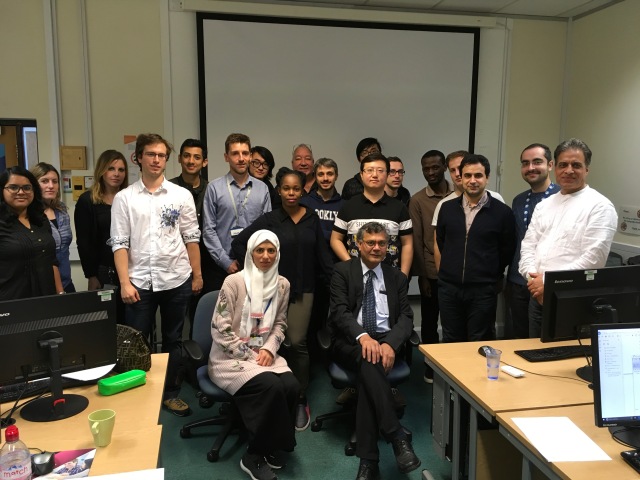

Who’s that good looking old boy at the back of the Matlab students?
LikeLiked by 1 person
Bloody hell it sounds complicated! Should’ve done humanities 😛
LikeLike
Cutting edge!
LikeLike